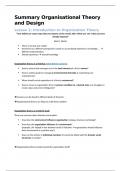Summary
Summary organisational theory and design (Steffi Weil) - UA 2024
- Course
- Institution
This is a summary of all lessons, required literature and guest lectures of the subject Organisational Theory and Design taught by Steffi Weil at the University of Antwerp.
[Show more]



